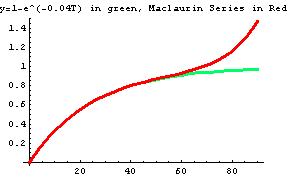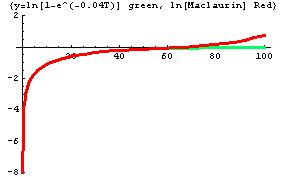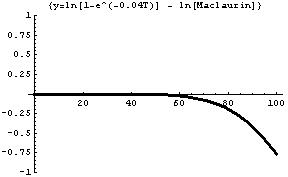Problem:
I want to solve the hop utilization equation for T (time in boil). I have included the gravity of the wort at any given time into my equation in an effort to (probably nominally) increase my estimation accuracy. You will find the condensed problem in bold at the end.
Equations:
I = (A*U*75)/G
Where:
I is the IBU value
A is the Alpha Acid Unit value (AAU = Alpha Acid value * Ounces)
U is the utilization value
G is the terminal volume post boil in gallons
So Algebraically: U=(I*G)/(75A)
U is calculated by the following:
U=Y*Z
Where:
Y=1.65*0.000125^(((S-1)G)/(RT+G))
(S= terminal gravity post boil)
(R=boil-off rate)
(T=time in minutes)
additional note: the gravity of any given point in time of the boil is represented here as
((S-1)G)/(RT+G). The S, G, R, and G values are known constants, the only variable here is T.
AND
Z=(1-e^(-0.04T))/4.15
Setting the two equations for U equal to one another, we have the equation I must manipulate to solve for time (T).
(I*G)/(75A) = [1.65*0.000125^(((S-1)G)/(RT+G))] * [(1-e^(-0.04T))/4.15]
So, come on and make my day! I can't figure out for the life of me where I'm going wrong, but I trust that I'm forgetting a key property with working with logarithms. I've been working on this for two days.
In shorter, more brief terms:
Solve for T:
(I*G)/(75A) = [1.65*0.000125^(((S-1)G)/(RT+G))] * [(1-e^(-0.04T))/4.15]
I want to solve the hop utilization equation for T (time in boil). I have included the gravity of the wort at any given time into my equation in an effort to (probably nominally) increase my estimation accuracy. You will find the condensed problem in bold at the end.
Equations:
I = (A*U*75)/G
Where:
I is the IBU value
A is the Alpha Acid Unit value (AAU = Alpha Acid value * Ounces)
U is the utilization value
G is the terminal volume post boil in gallons
So Algebraically: U=(I*G)/(75A)
U is calculated by the following:
U=Y*Z
Where:
Y=1.65*0.000125^(((S-1)G)/(RT+G))
(S= terminal gravity post boil)
(R=boil-off rate)
(T=time in minutes)
additional note: the gravity of any given point in time of the boil is represented here as
((S-1)G)/(RT+G). The S, G, R, and G values are known constants, the only variable here is T.
AND
Z=(1-e^(-0.04T))/4.15
Setting the two equations for U equal to one another, we have the equation I must manipulate to solve for time (T).
(I*G)/(75A) = [1.65*0.000125^(((S-1)G)/(RT+G))] * [(1-e^(-0.04T))/4.15]
So, come on and make my day! I can't figure out for the life of me where I'm going wrong, but I trust that I'm forgetting a key property with working with logarithms. I've been working on this for two days.
In shorter, more brief terms:
Solve for T:
(I*G)/(75A) = [1.65*0.000125^(((S-1)G)/(RT+G))] * [(1-e^(-0.04T))/4.15]



















![Craft A Brew - Safale S-04 Dry Yeast - Fermentis - English Ale Dry Yeast - For English and American Ales and Hard Apple Ciders - Ingredients for Home Brewing - Beer Making Supplies - [1 Pack]](https://m.media-amazon.com/images/I/41fVGNh6JfL._SL500_.jpg)







































